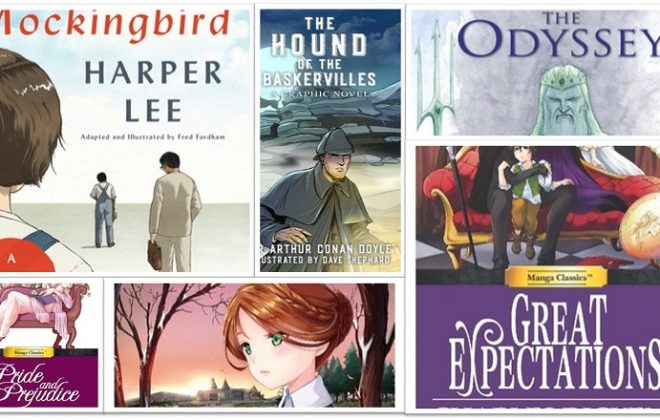
10 graphic novels to spark students’ interest in classic literature
By: Alecia Mouhanna, Marketing & Communications Specialist
For some students, finding out that their assigned reading list includes works by authors like Shakespeare or Dickens might inspire a sense of foreboding — or, at the very least, great reluctance. These texts can often present as dense or oddly formatted, full of archaic verbiage that requires reference after reference to footnotes. Confronted with the prospect of digging into a Romeo and Juliet or Great Expectations, younger readers (and older ones too, for that matter) might even invoke the dreaded “B” word – boring.
But it doesn’t have to be that way. Nowadays, there are many different mediums through which stories can be experienced, so it’s not always correct to assume that to understand classic literature, you need to read it…well, classically. Footnotes and all. This is where graphic novels can be a game-changer.
The benefits of reading graphic novels
Considering the rising popularity and acceptance of literary graphic novels as a genre (culminating this year with Jerry Craft’s Newbery Medal win for New Kid), it makes sense that graphic novels have also become an effective way to introduce students to classic works of literature. Here’s how one librarian describes the advantages to reading graphic novels/comics:
“We know that comics are especially beneficial to struggling or reluctant readers, as well as English-language learners. These books also offer all readers a way to practice important reading skills such as building vocabulary, understanding a sequence of events, discerning the plot of a story and making inferences. And comics give young readers training in visual literacy — helping them read and interpret images — an essential skill in our highly visual world.”
So for the student who might balk at such Shakespearean lines as “I fear too early, for my mind misgives; / Some consequence yet hanging in the stars, / Shall bitterly begin his fearful date” (Romeo and Juliet 1.4.113-115), a graphic novel can help make that dialogue more digestible by providing visual context.
Without changing the words themselves (much), a graphic novelization can enable readers to more easily connect statements with characters, gain a sense of setting and follow the action of the story. That, in turn, can aid them in cutting through the 16th century jargon to discern what the character Romeo is truly saying, which is that by opting to attend a party at the Capulet home, he’s afraid he’s making a poor decision that will have deadly repercussions down the line (SPOILER ALERT: He’s right).
And that’s just one example. There are plenty of others to choose from, with graphic novelizations available for many of literature’s standard-bearing works. Consider adding the 10 titles below to your collection to add a new dimension to your students’ classic lit consumption.
10 graphic novelizations of key literary classics for reluctant readers
1. Anne of Green Gables: A Graphic Novel
(based on the novel by L.M. Montgomery)
By Brenna Thummler · Mariah Marsden
2. The Count of Monte Cristo: Digital Edition
By Alexandre Dumas · Crystal S. Chan
3. Great Expectations: Digital Edition
By Charles Dickens · Crystal S. Chang
4. The Hound of the Baskervilles: A Graphic Novel
By Sir Arthur Conan Doyle · Dave Shephard
5. Jane Eyre: Digital Edition
By Charlotte Bronte · Crystal S. Chan
6. To Kill a Mockingbird: A Graphic Novel
By Harper Lee · Fred Fordham
7. Les Miserables: Digital Edition
By Victor Hugo · Crystal Chan
8. The Odyssey: A graphic novel
By Gareth Hinds
9. Pride and Prejudice: Digital Edition
By Jane Austen · Stacy King
10. Romeo and Juliet: Digital Edition
By William Shakespeare · Crystal S. Chan
Interested in more graphic novelizations?
Check out these lists to shop the above graphic novels and more:
Learn more about comics & graphic novels
Tags In
Browse blog and media articles
Public Library Training
K-12 Library Training